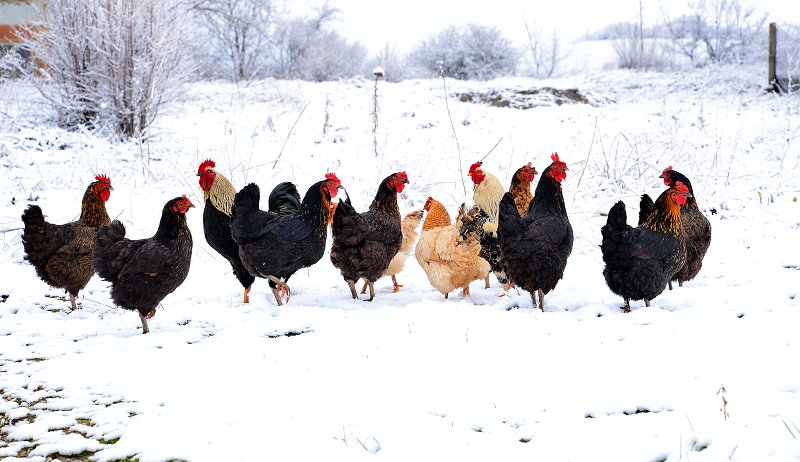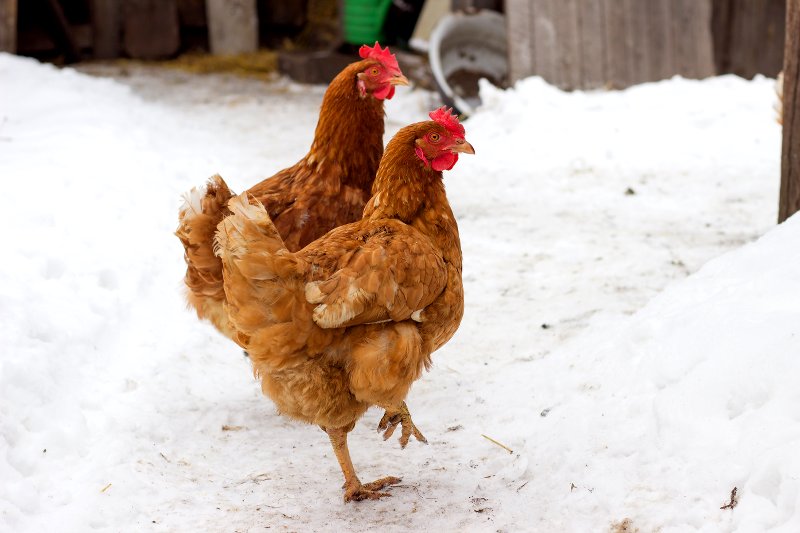
It’s the most wonderful time of the year! Your breath hangs like smoke in the air, the chill adds color to your cheeks, and the snow creates a sparkling pristine blanket over the land. For poultry keepers experiencing their first winter with chickens, these frigid months aren’t about the beauty of the season but about handling the challenges the cold weather brings. If this is your first winter with your chooks, here are a trio of troublesome issues you may face… and suggestions on how to resolve them.
1. Stop Waterers from Freezing
Nothing seems quite as piteous as a hen attempting to dip her beak in a fount saucer, only to knock it against rock-hard ice. When the mean temperatures dip below freezing, maintaining your flock’s water supply becomes a fight against nature. If your coop is wired for electricity, has solar-powered batteries or is outfitted with another source of power, your solution is a simple one: a base heater. These bases provide heat to metal waterers (do NOT use them with plastic founts) to keep the water within from freezing.
If your coop has no electricity, you can still use base heaters, provided you can run outdoor-grade extension cables from a protected outlet to your henhouse. My husband Jae does the electricity dance every fall, bringing power to our five coops using an assortment of orange, green and yellow cables. Unfortunately, this method is not foolproof: The ice that built up at the very first cable connection tripped the circuit for our outdoor outlet, and we couldn’t chip enough ice off to get the circuit to reset.
This left us with our original method of providing fresh water to our birds: lugging water out to the henhouse. Depending on how cold it is, you might need to do this more than once a day because the water you provide in the morning might be frozen solid by noon. We use several five-gallon buckets to ferry water to our birds; you’ll find these at hardware or home-improvement stores. You might need to pour hot water over the main section of the fount if it is frozen in place. Once you can take apart the waterer, pour the hot water onto the ice block inside to melt it. You can then add fresh drinking water. Yes, you need several buckets.
If you can afford it, buy a second set of waterers. This way, you can bring the frozen-solid founts into your garage, basement or other warm area to thaw, then take the backup waterers filled with fresh water out to your birds.
2. Prevent Eggs from Freezing
Several breeds of chicken, such as Cochins and Orpingtons, lay throughout the winter, despite the shortened amount of daylight. If you have outfitted your coop with artificial light, your hens will continue laying as if it were a sunny summer day. Having a source of fresh eggs during the colder months is fabulous—especially if you do a lot of holiday baking or simply love eating eggs. Not so fabulous is reaching into a nestbox and pulling out a rock-hard egg so frozen it has cracked the shell in several places.
Once the shell has cracked, there’s no saving the egg. It has been exposed to the dust, droppings and other unsanitary nasties found inside even the cleanest coop, and you certainly don’t want to ingest that. If your frozen egg has not breached its shell, it can be thawed, but its contents need to be used as soon as possible. Your best bet is to simply throw away all frozen eggs and devise a plan to save your hens’ efforts.
I employ two methods. First, I check nestboxes more often. During the warmer months, I check in the morning when I release the chickens, because many of my layers like to pop out their eggs at dawn. I check again in the early evening, a few hours before lockup. During the freezing months, I check during morning release, around lunch time, in the early evening and at lock up. I don’t get many eggs from my girls during this time of year, but the eggs I do find are still fresh.
During the cold season, I also boost the bedding in our nestboxes. Instead of just the usual nestpad, each nestbox also has an added inch to two inches of shavings to insulate any egg laid within. I also use dryer lint under the nestpads to add a protective buffer so the cold wood doesn’t chill the eggs from beneath.
3. Thwart Winter Boredom
Here in Michigan, it’s common for winter temperatures to dive below zero, and that’s not counting the wind chill. While we open our coops’ pop doors when it’s merely below freezing in case any birds want to stretch their legs, when the temperature goes below zero, we keep our chickens locked inside their coops.
This can get really old really fast. Think how stir crazy you get when you’re snowed in. You can’t wait for the snow plow to make the roads passable and release you from your temporary weather incarceration. Not so for the flocks locked in to protect them from the ravages of winter. Left to their own devices, they’ll start feather picking and pecking at each other. A bored flock is a flock heading for trouble.
Fortunately, you can keep your birds entertained during these bleak, chilly times. I’ve used these methods with our flocks, all quite successfully. In fact, I believe that my hens give me the stink eye when the weather warms up and they no longer receive these little in-coop entertainments from us.
- A quarter or half head of cabbage, which they peck and shred for hours.
- A scratch ball, filled with scratch grains. This chicken toy gets kicked around the coop, on purpose or by accident, leaving a trail of scratch for the chickens to enjoy.
- Dried mealworms, simply tossed onto the floor of the coop. The birds spend hours scratching and digging for these protein-filled snacks.
- Seed blocks. These can be small seed rectangles intended for wild birds or the sizable Flock Block by Purina. Either way, this compressed seed offering gives birds plenty to peck at and snack on.
- Hot breakfast. Chickens absolutely love warm oatmeal on a cold winter morning. Adding raisins and bits of dried fruit make it even more enjoyable.
- Suet blocks. This is another wild-bird offering that chickens adore—and it provides energy and heat for the winter.




